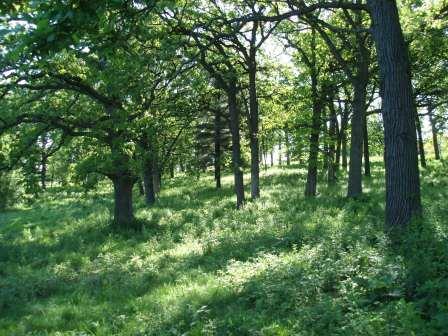by Carl Strang
One of my winter projects has been to write new sections for my singing insects guide which go into ecological topics. This was inspired by my reading a newly published textbook on landscape ecology (With, Kimberly A. 2019. Essentials of landscape ecology. Oxford University Press, Oxford, U.K. 641 pp). In the next few posts I will share parts of the added sections. Today’s focus is the impact of the last continental glacier on the landscape and selected insect species:
Though the focus in most of this guide is on the individual species of singing insects, the field of landscape ecology provides a framework of broader patterns and questions for which the ecologically diverse singing insects provide a suitable lens.
Landscape ecology considers geographical patterns and dynamics of their change across time. Any complete biological understanding of the Chicago region must include not only what is here now but also how it got that way. Fortunately, we don’t have to go back too far geologically speaking, as our landscape is less than 20,000 years old. Three major lobes of the most recent continental glacier flowed down from the North and scoured our region’s bedrock, then began their final retreat around 18,000 years ago. As the glacier melted, with occasional periods of stalling when the push from the North was balanced by melting at the edge, it left behind a variably deep layer of various kinds of deposits. The topography was more elevated in the morainal arcs where the melt was stalled for a time, lower and flatter when the melt-back was more uniform and rapid. Occasional pocks formed where blocks of glacial ice were buried and later melted, resulting in small lakes, bogs and other wetlands. Our rivers had their start as glacial meltwater drainage streams. The Lake Michigan Lobe of the glacier picked up and crushed the softer shale from the bottom of what was to become that lake, so it left behind deposits heavy in clay west and southwest of the lake. When glacial crunching and meltwater eroded harder igneous and metamorphic rocks the ice had transported from Canada, gravel and sand resulted. Quartz sand, the most erosion-resistant component of such rocks, accumulated especially around the edge of Lake Michigan and the tributaries of the Kankakee River, which started as a glacial meltwater drainage stream originating in the part of the region covered by the glacier’s Saginaw Lobe.
This glacial history impacted our singing insect fauna in various ways. Some species require, or at least are only abundant, on sandy soils. These include the green-winged and northern dusk-singing cicadas, whose nymphs live on buried plant roots, and some of the grasshoppers, for which the sandy substrate for egg-laying and/or a poor-soil plant community is an important habitat component. A couple of species, the gray ground cricket and the seaside grasshopper, are limited to the beaches and dunes around the Lake Michigan edge.

The beaches at different points on the Lake Michigan shore have different compositions, resulting in selection for different colors in the seaside grasshopper. Here, at Illinois Beach State Park, there is a greater mix of different colors of ground igneous and metamorphic rocks.

The beaches of the Indiana Dunes are a more uniform quartz sand. Here, two seaside grasshoppers (same species as in the previous picture) would be nearly invisible if they were not flashing their inner femur colors at one another.
Kames are gravel hills formed by waterfalls within the melting glacier, and they provide a well-drained substrate. Isolated populations of sulfur-winged grasshoppers and tinkling ground crickets live on a kame in the Lulu Lake Nature Preserve in northern Walworth County, Wisconsin.
All species were pushed south by the glacier, surviving in what is now the southern U.S. and being influenced by selective forces then and during the advance north as the climate moderated and plant communities spread back over the barren glacial deposits. Most of our familiar prairie and forest plant species were restricted to rather small refuges in the South during the glacial maximum, though oaks and hickories occupied a large part of the southern U.S.
As the glacier melted back, open sedge tundra with some black spruce trees invaded first, then white spruces filled in to form a recognizable northern coniferous forest until around 15,000 years ago. By around 12,000 years ago most of our landscape was a mix of deciduous species, including woodlands with lots of oaks. Beginning around 10,000 years ago there was a drying period, which led to the spread of prairie through our area. The prairie then retreated as the climate became wetter, so that by 6200 years ago the western part of our region was a prairie with islands of woodlands and wetlands, grading to forest in the eastern part. This reflects a gradient of increasing moisture from west to east, mediated by the flow of wet air circulating north from the Gulf of Mexico. The drier prairies were maintained by fires which frequently knocked back woody plants that otherwise would have converted even the western part of the region into woodlands. The wooded islands within the prairie were not randomly located, but survived where rivers, other wetlands, and topographic breaks shielded certain spots from prairie fires pushed by the prevailing westerly winds. The upshot for our singing insects is a diverse landscape that to this day contains species specializing in prairie, woodland and various wetland habitats, as well as some that thrive around the edges between habitat types. A few species may be relicts of earlier changes in this history. For instance, the delicate meadow katydid, now apparently extinct in the region, is abundant in prairies to the west and probably accompanied the prairie advance. By the early 20th Century it was known in a very few scattered locations. I have not been able to find it anywhere in the present day.



























